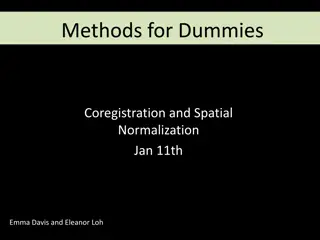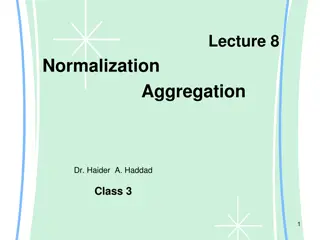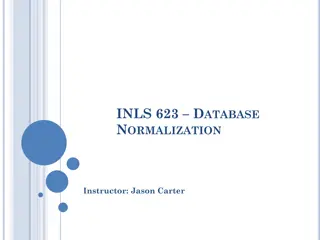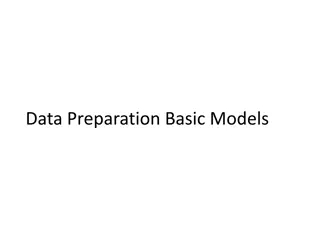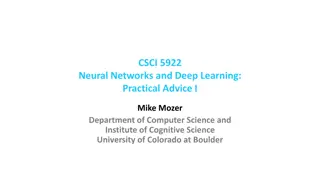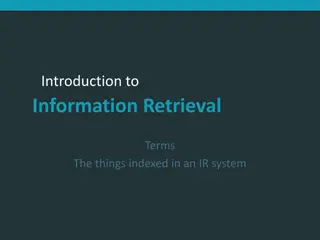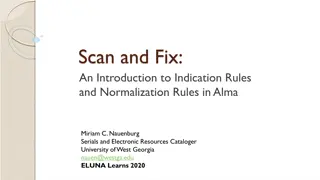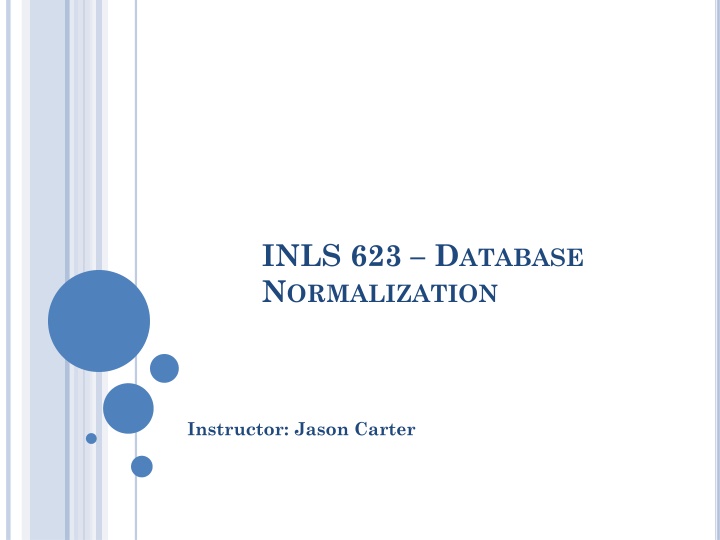
Database Normalization and Set Theory in INLS 623: Key Concepts Explained
Explore the fundamental concepts of database normalization and set theory taught by Instructor Jason Carter in the course INLS 623. Learn about keys, sets, subsets, super keys, and candidate keys with practical examples and explanations. Understand how set theory relates to databases and discover the importance of minimal superkeys in data management. Enhance your understanding of database design through clear explanations and visual aids.
Download Presentation

Please find below an Image/Link to download the presentation.
The content on the website is provided AS IS for your information and personal use only. It may not be sold, licensed, or shared on other websites without obtaining consent from the author. If you encounter any issues during the download, it is possible that the publisher has removed the file from their server.
You are allowed to download the files provided on this website for personal or commercial use, subject to the condition that they are used lawfully. All files are the property of their respective owners.
The content on the website is provided AS IS for your information and personal use only. It may not be sold, licensed, or shared on other websites without obtaining consent from the author.
E N D
Presentation Transcript
INLS 623 DATABASE NORMALIZATION Instructor: Jason Carter
KEYS Primary Key Secondary Key(s) Candidate Key(s) Foreign Key(s)
SET THEORY Set A collection of zero or more distinct objects. What does set theory have to do with databases? A record is a set of attribute/property values Columns are a set of attributes Rows are a set of records Conventionally sets are denoted with capital letters A = {1,2,3} B = {2,1,5} C = {red, green, blue}
SETS Equality {6, 11} = {11, 6} = {11, 6, 6, 11} . {1,2} = {2,1} Membership A = {1,2,3,4} = member of 4 A, 1 A, 3 A, 2 A = not a member of 6 A
SETS Subsets a set A is a subset of a set B if all members of set A is also a member of set B = subset A = {1,3} B = {1,2,3,4} {1, 3} {1, 2, 3, 4} A B
SETS Superset a set B is a superset of a set A if all members of set A are members of set B = superset A = {1,3} B = {1,2,3,4} {1, 2, 3, 4} {1, 3} B A
SUPER KEY Formal definition A superkey of a relation schema R = {A1, A2, ...., An} is a set of attributes S subset-of R with the property that no two tuples t1 and t2 in any legal relation state r of R will have t1[S] = t2[S] A key K is a superkey with the additional property that removal of any attribute from K will cause K not to be a superkey any more. A superkey is a combination of attributes that can be uniquely used to identify a database record. A superkey can be just one column.
SUPER KEY EXAMPLE A superkey is a combination of attributes that can be uniquely used to identify a database record. A relation book R(BookId, BookName, Author) What are possible superkeys? (BookId) (BookId,BookName) (BookId, BookName, Author) (BookId, Author) (BookName, Author)
MINIMAL SUPERKEY The minimum number of columns, which when combined, will give a unique value for every row in the table Candidate keys are minimal superkeys A relation book R(BookId, BookName, Author) What are possible candidate keys? BookId (BookName,Author)
KEYSAND ATTRIBUTES A Prime attribute is a member of some candidate key R(BookId, BookName, Author) BookId (BookName,Author) A Nonprime attribute is not a prime attribute that is, it is not a member of any candidate key. R(BookId, BookName, Author) Author BookName
WHATIS NORMALIZATION? A technique to organize efficiently organize data in a database Efficiently : Eliminating redundant data Not storing the same data in more than one table Ensuring that functional dependencies make sense
FUNCTIONAL DEPENDENCIES Formal Definition Let R be a relation and X and Y be two sets of attributes/properties in that relation. X Y (X determines Y) if and only if each X value is associated with precisely one Y value A dependency occurs when information stored in the same table uniquely determines other information stored in the same table.
FUNCTIONAL DEPENDENCIES EXAMPLES A dependency occurs when information stored in the same table uniquely determines other information stored in the same table. SSN First Name Last Name Age 343-33333 Jack Doe 21 398-34533 Jane Doe 25 500-33333 Jill Roy 32 700-33333 Jane Doe 50 SSN Age SSN FN SSN LN
NORMAL FORM 1st Normal Form 2nd Normal Form 3rd Normal Form Boyce-Codd Normal Form (3.5 Normal Form) 4th Normal Form
1ST NORMAL FORM Every cell in the table is atomic A cell value cannot be divided further Seen differently there are no grouping of information inside a cell. No duplicate rows
1ST NORMAL FORM Student Id First name Bob Joe Alice Shelly Last name Wood Smith Boone Kent Grades Classes 1 2 3 4 C,B A,D A,A A,B 401, 623 550, 823 890,991 770,881 Does this table violate first normal form?
1ST NORMAL FORM Student Id First name Bob Joe Alice Shelly Last name Wood Smith Boone Kent Grades Classes 1 2 3 4 C,B A,D A,A A,B 401, 623 550, 823 890,991 770,881 Grades and Classes have multiple rows of data in one column
1ST NORMAL FORM Student Id First name Bob Joe Alice Shelly Bob Joe Alice Shelly Last name Wood Smith Boone Kent Wood Smith Boone Kent Grades Classes 1 2 3 4 5 6 7 8 C A A A B D A B 401 550 890 770 623 823 991 881 Create new rows
2ND NORMAL FORM Table must be in 1st Normal Form An attribute is in a 2NF table if and only if it is fully functionally dependent on every candidate key. Example: R(CourseId, SectionNum, Instructor, TA) Candidate Key: CourseId, SectionNum Functional Dependency = {CourseId, SectionNum Insructor, CourseId, SectionNum TA}
2ND NORMAL FORM Full functional dependency:a FD Y Z where removal of any attribute from Y (LHS) means the FD does not hold any more FD since neither EmployeeName HrsWkd nor Proj HrsWkd hold {EmployeeName, Project} HrsWkd is a full A partial dependency occurs if some attribute can be removed and the dependency still holds since SSN EmployeeName also holds {SSN, Proj} EmployeeName is not a full FD
2ND NORMAL FORM Ssn = Social Security Number Pnumber = Project Number Hours = # of hours person worked on project Ename = Employee Name Pname = Project name Plocation = Project location Is this table in 2NF?
2ND NORMAL FORM What is the primary key? Are there other candidate keys? What are the non prime attributes? Hours, Ename, Pname, Plocation Ssn Pnumber
2ND NORMAL FORM Non prime attributes Hours Is {Ssn, Pnum} {hours} a FFD? Ename Is {Ssn, Pnum} {Ename} a FFD? Pname Is {Ssn, pnum} {Pname} a FFD? Plocation Is {Ssn, pnum} {Plocation} a FFD? Yes No, problem is FD2 No, problem is FD3 No, problem is FD3
2ND NORMAL FORM Table 1 Table 2 Table 3
3RD NORMAL FORM Table must be in 2nd Normal Form A relation is in 3NF if it is in 2NF AND no nonprime attributes are transitively dependent on all candidate keys.
TRANSITIVELY DEPENDENT Formal definition Y is transitively dependent on X if the only way to derive X Y is through using X Z and Z Y for some Z that is not a subset of Z or Y.
3RD NORMAL FORM X = {Ssn}, Y = {Dmgr_ssn}, Z = {Dnumber} Definition: A FD X Y is a transitive dependency if there is a set of attributes Z that is neither a candidate key nor a subset of any key, and both X Z and Z Y hold. Ssn Dnumber and Dnumber Dmgr_ssn Ssn Dmgr_ssn
3RD NORMAL FORM Dmgr_ssn is a nonprime attribute {ssn} {Dmgr_ssn} is a transitive dependency (based on {Dnumber}) EMP_DEPT is NOT in 3rd Normal Form
DECOMPOSITIONTO 3RD NORMAL FORM Goal: Decompose to remove the transitive dependency that caused the problem {ssn} {Dmgr_ssn} is a transitive dependency (based on {Dnumber}) Notice: Must put Dnumber in BOTH tables
3RD NORMAL FORM Table is in 2nd normal form, but not in 3rd normal form Tournament Winners Winner Date of Birth Tournament Year Winner Indiana Invitational 1998 Al Fredrickson 21 July 1975 28 September 1968 Cleveland Open 1999 Bob Albertson Des Moines Masters Indiana Invitational 1999 Al Fredrickson 21 July 1975 1999 Chip Masterson 14 March 1977 {Tournament, Year} Candidate key? http://en.wikipedia.org/wiki/Third_normal_form
3RD NORMAL FORM Tournament Winners Tournament Indiana Invitational Cleveland Open Des Moines Masters Indiana Invitational Year Winner Winner Date of Birth 1998 Al Fredrickson 21 July 1975 1999 Bob Albertson 28 September 1968 1999 Al Fredrickson 21 July 1975 1999 Chip Masterson 14 March 1977 Winner Date of Birth is transitively dependent on the candidate key {Tournament, Year} Non-prime attribute Winner Winner Date of Birth Winner Winner Date of Birth is fully dependent on Winner Winner {Tournament, Year} Winner Date of Birth is transitively dependent on {Tournament, Year}
3RD NORMAL FORM There is nothing to stop the same person from being shown with different dates of birth on different records. Tournament Winners Tournament Indiana Invitational Cleveland Open Des Moines Masters Indiana Invitational Year 1998 1999 1999 1999 Winner Al Fredrickson Bob Albertson Al Fredrickson Chip Masterson Winner Dates of Birth Winner Date of Birth 14 March 1977 21 July 1975 28 September 1968 Chip Masterson Al Fredrickson Bob Albertson



